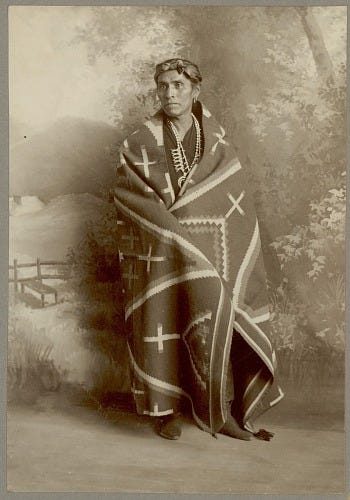Our style matters.
Let's talk about Black style, setting the record straight on Navajo textiles, new projects and... we're in the news!
Hello everyone,
This week’s letter introduces you to a textile from a widely appropriated culture, suggests a ‘summer starter pack’ with books on Black style and invites you to build a virtual photo album with us!
We want to thank you for your support–our subscriber base and social media following has grown tremendously, and we’ve had some pretty amazing shout-outs in the media over the past few weeks:
Article: ‘Kimberly M. Jenkins on Her Revamped Fashion and Race Database and the Need for Change’ - VOGUE
Article: ‘Why its time to decolonise fashion’ - The Guardian
Article, video and podcast episode: ‘Scholar Kimberly Jenkins on fashion, race and Viola Davis’s Vanity Fair cover’ - NOW Toronto
Video: eTalk ‘Exclusive’ via CTV sits down with Kim Jenkins to discuss the need for greater representation for BIPOCs
Article: ‘Kimberly Jenkins Wants To Help Decolonize Our Understanding Of Fashion’ - FASHIONISTA
Article: ‘8 Books About Fashion And Race You Need To Read Now’ -GRAZIA Middle East
Article: ‘Kimberly Jenkins Relaunches The Fashion And Race Database’ - CR Magazine
Objects That Matter: Navajo Blankets
Navajo blankets are carefully constructed textiles that embody a cultural appreciation for craftsmanship, innovation and individuality. Weaving is an important aspect of Navajo or Diné society and spirituality.
Research Assistant Adriana Hill authored our very first ‘Objects That Matter’ post and, since we relaunched, Adriana has greatly expanded our database when it comes to Native American, First Nation and Indigenous culture. A nuanced textile from a widely appropriated culture, let Adriana introduce you to the Navajo Blanket and its significance.

Portrait of Tom Ganado with blanket and squash blossom necklace, 1906. Photograph, 15.24 x 17.78 cm. National Anthropological Archives, Smithsonian Institution, NAA INV 03271600, Photo Lot 59.
Is there an object you’d like to write about and add to our growing canon of marginalized or mis-appropriated fashion? Pitch the object via our contributor page.
The Library: Black Style Matters
Our Library provides an ever-expanding collection of resources on fashion history, but let’s distinguish ‘fashion’ from ‘style’ this week. When it comes to ‘style’ and ‘styling,’ we are talking about the everyday practice of constructing a ‘look.’ When we put together our look, it involves a series of decisions that are informed by our upbringing, our community, our mood, our experiences and how we wish to be ‘seen.’
The construct of race complicates the way we style or ‘fashion’ ourselves each day, as our decisions in how we look may challenge or comply with dominant narratives that influence us. Though, of course, some of us may be ambivalent and say that we don’t put much thought into the way we look. Yet when it comes to the Black, lived experience, there is much to be said about the way dress and hairstyling is critical in making a statement, building community and refining one’s self-definition.

Let’s celebrate Black style together. Here’s a few books/catalogs to get you started:
Collegiate Fashion & Activism: Black Women’s Styles on the College Campus by Dyese Matthews & Kelly L. Reddy-Best (the above photo is featured in this exhibition catalog)
The Birth of Cool by Carol Tulloch
Slaves to Fashion by Monica L. Miller
Dandy Lion: Black Dandy and Street Style by Shantrelle P. Lewis
Dressed in Dreams by Tanisha C. Ford
We add new sources weekly, so head over to The Library for a full spectrum of books, articles, videos and podcast episodes that further address this topic.
Call for Contributors: ‘Our Fashion History’
We view fashion history as a patchwork of diverse stories, threaded together by the ingenuity and often-unseen contributions of BIPOC individuals over time. This includes the humble, everyday photos of our BIPOC family members who have used dress and adornment to fashion a sense of resilience and a stylish life for themselves.
Do you have a story to tell? We invite short essays of 500-800 words narrating 3-5 family photos to help us expand the conventional narrative of fashion history. Our rate for contributing 500-800 words is $295 CAD. Visit the contributor page for details and to send us your pitch.

Photo: Uncle Bruce (ca. 1950s), from the family archive of Founder Kim Jenkins.
Keep the content going
Our fundraising continues, so if you have the capacity to give, visit our donation page. If you have questions about making a gift, please contact rachel@fashionandrace.org. Continued support directly funds our upcoming endeavors, like publishing topic-based mini-lectures by scholars we trust on our platform.
See you next week! Yours in service and solidarity,
The Project Team
(Kim, Rachel, Adriana, Safia)



